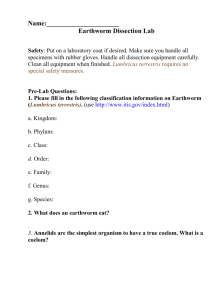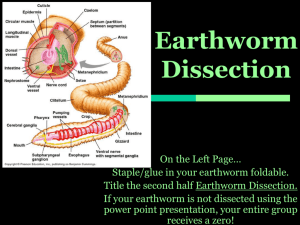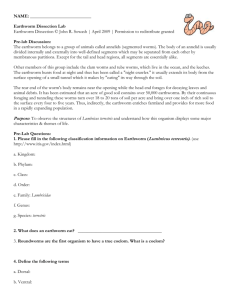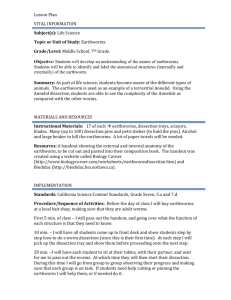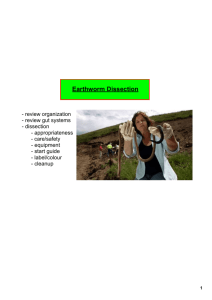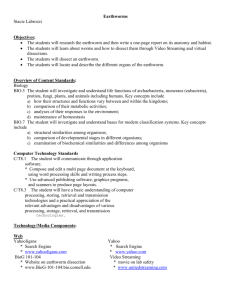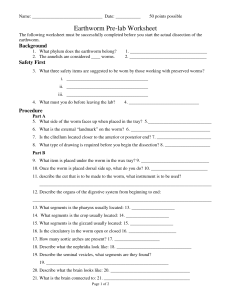Click Here for the Earthworm Dissection Pre-Lab
advertisement
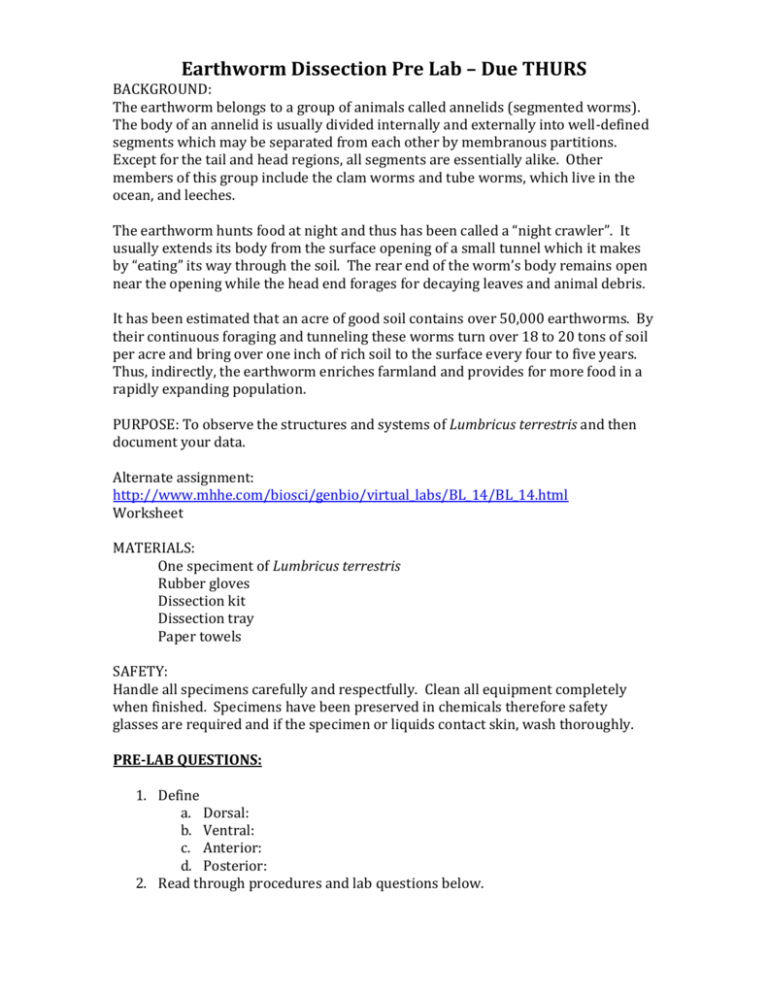
Earthworm Dissection Pre Lab – Due THURS BACKGROUND: The earthworm belongs to a group of animals called annelids (segmented worms). The body of an annelid is usually divided internally and externally into well-defined segments which may be separated from each other by membranous partitions. Except for the tail and head regions, all segments are essentially alike. Other members of this group include the clam worms and tube worms, which live in the ocean, and leeches. The earthworm hunts food at night and thus has been called a “night crawler”. It usually extends its body from the surface opening of a small tunnel which it makes by “eating” its way through the soil. The rear end of the worm’s body remains open near the opening while the head end forages for decaying leaves and animal debris. It has been estimated that an acre of good soil contains over 50,000 earthworms. By their continuous foraging and tunneling these worms turn over 18 to 20 tons of soil per acre and bring over one inch of rich soil to the surface every four to five years. Thus, indirectly, the earthworm enriches farmland and provides for more food in a rapidly expanding population. PURPOSE: To observe the structures and systems of Lumbricus terrestris and then document your data. Alternate assignment: http://www.mhhe.com/biosci/genbio/virtual_labs/BL_14/BL_14.html Worksheet MATERIALS: One speciment of Lumbricus terrestris Rubber gloves Dissection kit Dissection tray Paper towels SAFETY: Handle all specimens carefully and respectfully. Clean all equipment completely when finished. Specimens have been preserved in chemicals therefore safety glasses are required and if the specimen or liquids contact skin, wash thoroughly. PRE-LAB QUESTIONS: 1. Define a. Dorsal: b. Ventral: c. Anterior: d. Posterior: 2. Read through procedures and lab questions below. DISSECTION ASSIGNMENTS: Group Leader:__________________________________________________ Double S (Sanitary Specialist):______________________________________________ Data Specialist:________________________________________________ PROCEDURE DURING LAB: (read through for pre-lab, answer during lab) 1. The body of the earthworm is comprised of over 100 segments. Each segment looks like a ring. The segments are numbered in sequence from the anterior end. Numbers in the diagrams refer to the segment number. Locate the dorsal (more rounded), ventral (flatter), anterior and posterior regions of the earthworm and make observations below. 2. Pin worm to dissecting pan. Using a scalpel or scissors, carefully make a shallow incision in the dorsal side of the clitellum at segment 33. CAUTION: Scalpels and scissors are very sharp. Report any cuts to your teacher. Using forceps and scalpel, spread the incision open, little by little. Separate each septum from the central tube using a dissection pin, and pin down each loosened bit of skin. In order to see the pharynx and ganglion (brain), you must open the worm all the way to segment 1. Write down what you observe: What organs and organ systems do you observe? 3. Use the figure below to locate and identify the five aortic arches or hearts. Then find the median dorsal vessel. Look for smaller blood vessels that branch from the dorsal vessel. 4. Locate the digestive tract. Refer to the figure to locate the pharynx, esophagus, crop, gizzard, and intestine. To find organs of the nervous system, carefully push aside the digestive and circulatory system organs with your probe. Use the figure to locate the ventral nerve cord. Trace the nerve cord forward to the nerve collar, which circles the pharynx. Locate the cerebral ganglion under the pharynx. The ganglia above the pharynx serve as the brain of the earthworm. How do the organs and organ systems in the earthworm relate to the human body organs and organ system? Give 3 examples. 1. 2. 3. 5. When the dissection is complete: -contain all organs and tissues from the dissection & raise hand to dispose of organic material properly -completely clean, dry and place your dissection instruments back in their kits. Clean and dry the dissection tray. Lay a dry paper towel in the dissection tray. When complete, raise your hand to be approved by the teacher -complete the post lab questions
